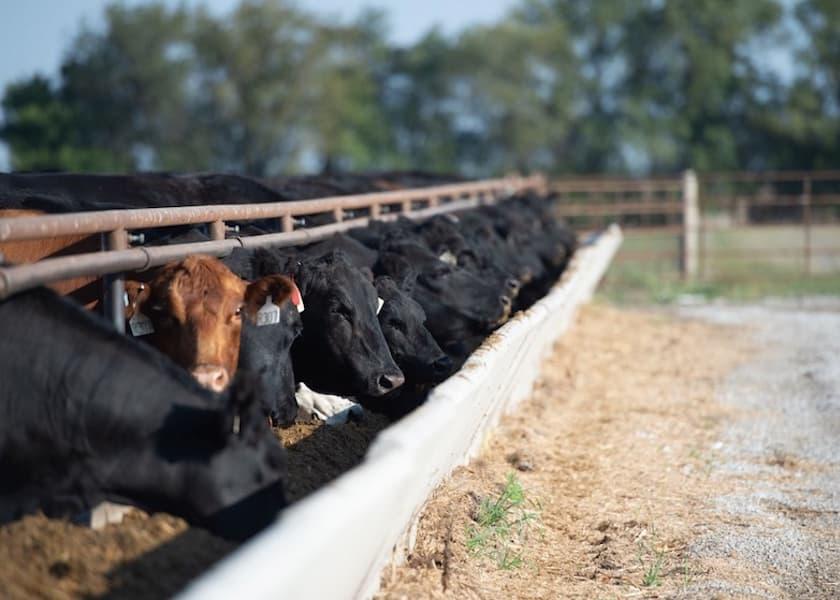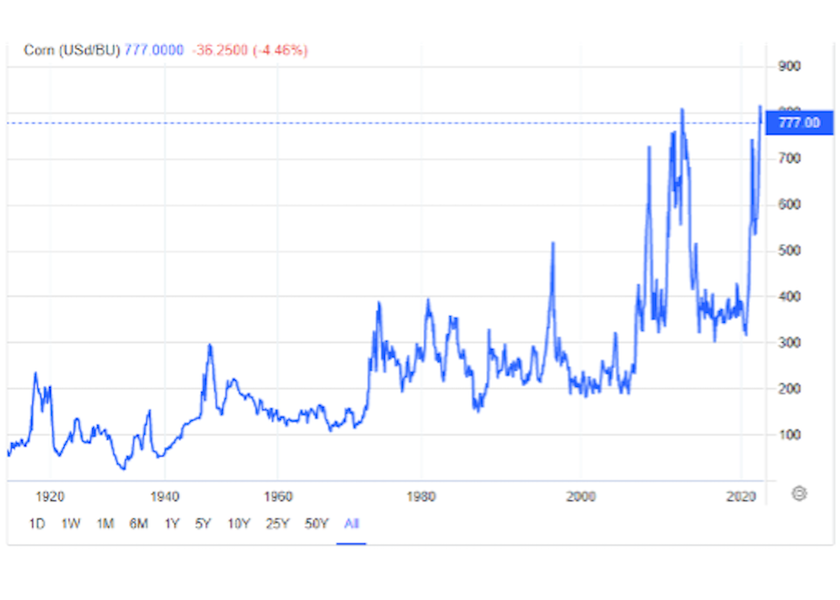Protect and Optimize Cattle Cost of Gain Into 2023

Feed prices have been on the rise for some time now—with this year’s surge at a painstaking high. This is due to an increase in commodity pricing (e.g., corn) which has reached a level seen only one other time in U.S. agricultural history.
2022 Marks the Second Time in History Corn Prices Have Exceeded $8/Bushel1
2021 ration prices and cost of gain increases were 35–40% year over year,
with continued challenges in 2022.1
According to Nathan Pyatt, PhD, beef technical consultant with Elanco Animal Health, there’s a silver lining, with producers reporting profitability in several regions for finished cattle (even with feed cost spikes). “We celebrate this win, yet also advise producers to take steps now to protect their cattle’s market value this season and into 2023. Optimizing feed efficiency and cost of gain is the research-backed method I’m advising clients to start conversing about now.”
The potential for summer droughts and an uncertain fall corn yield may require updating the nutritional program. Following are key insights from conversations Dr. Pyatt is having in the field with colleagues, feedlot owners and top beef producers on sought-after feed efficiency resources.
Differentiate Cattle Type and Marketing End Point
One of the obvious ways to manage feed costs is to feed less. This could be achieved through fewer days on feed and/or finishing your cattle at lighter weights and leaner compositional end points. It’s important to understand packer expectations in these cases to ensure that making these feed changes does not put you below the ROI line.
Pursue a Best-Cost vs. a Least-Cost Feed Diet
Another proactive practice is to make feed changes by evaluating what Dr. Pyatt calls best-cost diets to optimize performance, versus least-cost diets that meet requirements as inexpensively as possible. The best-cost diet protocol implements feed additive technologies through supplementation. For example, Rumensin® maintains gain while reducing feed investment without affecting the long-term end point.
Rumensin is a product that doesn’t require major diet or management changes; thus, increasing the dose promotes incremental improvements in feed efficiency. The rule of thumb based on peer-reviewed research is that every 100 mg increase in Rumensin results in about a 1% improvement in feed efficiency—incremental net returns are greater in seasons when feed costs are high.2
Integrate Technologies Into Your Approach
Cattle producers could also consider integrating technologies that improve daily gain, including adding a beta-agonist like Optaflexx® during the late feeding period to help maintain efficiency as long as possible while cattle are slowing down biologically.2
Tap Into Expert Knowledge
During times like these, your nutritionist is an invaluable resource who can help provide you with practical solutions to optimize feed costs. Be sure to have an open dialogue so that you can carefully weigh the options to decide what might be feasible in order to maintain efficiency, sustainability and profitability.
While a number of large-scale alternatives can be considered in terms of end-point management, some practices can be fine-tuned to make big improvements in feed efficiency and cost of gain. Contact your Elanco Animal Health representative to learn more about how Rumensin and Optaflexx can help improve feed efficiency.
The Bottom Line
Making a proactive decision to incorporate a feed additive and/or technology is a smart way to protect and optimize your cattle’s market value. Dr. Pyatt shares, “In some ways, the destiny of the marketplace is set right now, but producers can maximize high demand this summer while at the same time making proactive preparations for the seasons ahead.”
For all products: The label contains complete use information, including cautions and warnings. Always read, understand and follow the label and use directions.
CAUTION: Consumption by unapproved species or feeding undiluted may be toxic or fatal. Do not feed to veal calves.
For Rumensin:
Growing beef steers and heifers fed in confinement for slaughter:
For improved feed efficiency: Feed 5 to 40 g/ton of monensin (90% DM basis) continuously in a complete feed to provide 50 to 480 mg/hd/day.
For the prevention and control of coccidiosis due to Eimeria bovis and Eimeria zuernii: Feed 10 to 40 g/ton of monensin (90% DM basis) continuously to provide 0.14 to 0.42 mg/lb of body weight/day, depending upon severity of challenge, up to a maximum of 480 mg/hd/day.
For Optaflexx:
CAUTION: Not for animals intended for breeding.
Complete feed
For increased rate of weight gain and improved feed efficiency in cattle fed in confinement for slaughter: Feed 8.2 to 24.6 g/ton of ractopamine hydrochloride (90% DM basis) continuously in a complete feed to provide 70 to 430 mg/hd/d for the last 28 to 42 days on feed.
For increased rate of weight gain, improved feed efficiency and increased carcass leanness in cattle fed in confinement for slaughter: Feed 9.8 to 24.6 g/ton of ractopamine hydrochloride (90% DM basis) continuously in a complete feed to provide 90 to 430 mg/hd/d for the last 28 to 42 days on feed.
Top dress
For increased rate of weight gain and improved feed efficiency in cattle fed in confinement for slaughter: Feed 70 to 400 mg/hd/d of ractopamine hydrochloride (90% DM basis) continuously in a minimum of 1.0 lb/hd/d top dress Type C medicated feed (maximum 800 g/ton ractopamine hydrochloride) during the last 28 to 42 days on feed.
1Trading Economics. Corn2022data. 1912-2021 Historical. 2023 Forecast. Chart.
2Elanco Animal Health. Data on file.
3Pyatt NA, Vogel GJ. Effects of ractopamine hydrochloride on performance and carcass characteristics in finishing steers: 32-trial summary. J Anim Sci. 2013;91(E-suppl. 1):79.
Optaflexx, Rumensin, Elanco and the diagonal bar logo are trademarks of Elanco or its affiliates.
© 2022 Elanco or its affiliates.
PM-US-22-1266









